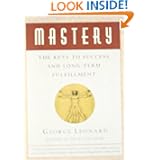Since we spend so much time trying to improve our golf games, I thought I’d start this thread about the nature of mastering any skill. This original post borrows heavily from George Leonard’s book, Mastery. (Shown below: It’s an excellent read, by the way – I highly recommend it, and not just for golf!)
In his book, he takes a look at how learning occurs, using training examples from golf, tennis, and aikido.
He states that the path to mastering any skill set looks something like this:

Learning takes place in apparent “spurts” separated by plateaus. In his words:
On the road to mastery, some of us are what he calls “hackers.” (I wonder where he came up with that term?) He describes hackers as those individuals who are content to stay on one plateau forever, who aren’t willing to work to improve.
Leonard is not saying that we all need to become masters at every aspect of life. He is simply pointing out the pitfalls along the path to mastery, and also showing how modern society & cultural values are essentially “anti-mastery”, and absolutely “anti-plateau”.
While the name of this site is The Hackers Paradise, I think many here are working hard at moving along the path to mastery of golf.
I am definitely a hacker. I’ve been playing golf at the same level for most of my life. And there is certainly nothing wrong with being a hacker! But at this point in my life, I am willing to do more, to work harder than I ever have to become better. And one of the first steps to me becoming better is to (in Leonard’s words) Learn to love the plateau.
What can and does happen when you first start training is one event (that first lesson, a new club, etc.) causes a sudden improvement on your game. You get excited, and start working harder on your game, expecting that you should see a similar rate of improvement (or at least some outward sign of improvement) over time. When it doesn’t happen, when it appears like you’re not getting any better, it can be easy to abandon what we’re working on and look for a different course of action.
It can be very frustrating to work hard on your swing and see no real progress, or even seem to go backwards for a while. Modern culture is all about the quick fix. It’s easy to get bored or distracted, or try another “remedy” or swing tip or new equipment – hoping to hit the jackpot.
But being on the plateau is like the story of the Chinese bamboo tree (I got this from Hank Johnson’s book, How to Win the Three Games of Golf – which is another excellent, must-read too!):
Leonard took up aikido at age 47, and eventually became a black belt and opened his own school. He uses martial arts and Eastern philosophy to make points about becoming a master. He relates how he used to be impatient to learn the next thing and see improvement, but over time, he learned to really love the day-to-day process of learning, whether or not improvement was evident or not. He came to see that the people who became masters did so not so much by talent but by mindful practice.
Two more quotes from his book:
JB asked the question in an earlier thread, “Why Don’t You Take Lessons?” and many said with the limited time and money, they made a choice to play over practice. That has always been me. I’ve always felt like even if I did take lessons, I wouldn’t follow through on the work in between lessons to gain any benefit.
This year, I am making a conscious choice to work hard, and learn to love any plateaus that come along while I’m practicing. I am going to find the Zen-like quality of practicing in the present moment, and learn to appreciate subtle changes in my swing and my game. I am going to enjoy practicing – I’m going to get lost in the moment, to look at being on the plateau as a gift of time to myself.
I’m already doing this with my putting practice. I am starting to really love the times I work on my putting green in the basement. I’m not doing it hours at a time or anything, just 10-20 minutes here and there. But I’m not focusing on my goal of 10-in-a-row, or whatever. I am starting to really pay attention to how I grip the club, how each swing differs from the last, how my shoulders feel each time; and I’m starting to notice small things I missed even a few weeks ago. I can’t say that I’m becoming an excellent putter. I can say that I’m more aware of what I’m doing, and eventually – with practice – I expect I’ll be a better putter.
I hope those of you who are working on improving your swings and your golf game will post here about your experiences with being on the plateau. Hopefully, these posts will ease some of the frustrations and impatience we have and keep us going along the path to mastery.


In his book, he takes a look at how learning occurs, using training examples from golf, tennis, and aikido.
He states that the path to mastering any skill set looks something like this:
Learning takes place in apparent “spurts” separated by plateaus. In his words:
“To take the master’s journey, you have to practice diligently, striving to attain new levels of competence. But while doing so – and this is the inexorable fact of the journey – you also have to be willing to spend most of your time on a plateau; to keep practicing even when you seem to be getting nowhere.”
On the road to mastery, some of us are what he calls “hackers.” (I wonder where he came up with that term?) He describes hackers as those individuals who are content to stay on one plateau forever, who aren’t willing to work to improve.
Leonard is not saying that we all need to become masters at every aspect of life. He is simply pointing out the pitfalls along the path to mastery, and also showing how modern society & cultural values are essentially “anti-mastery”, and absolutely “anti-plateau”.
While the name of this site is The Hackers Paradise, I think many here are working hard at moving along the path to mastery of golf.
I am definitely a hacker. I’ve been playing golf at the same level for most of my life. And there is certainly nothing wrong with being a hacker! But at this point in my life, I am willing to do more, to work harder than I ever have to become better. And one of the first steps to me becoming better is to (in Leonard’s words) Learn to love the plateau.
What can and does happen when you first start training is one event (that first lesson, a new club, etc.) causes a sudden improvement on your game. You get excited, and start working harder on your game, expecting that you should see a similar rate of improvement (or at least some outward sign of improvement) over time. When it doesn’t happen, when it appears like you’re not getting any better, it can be easy to abandon what we’re working on and look for a different course of action.
It can be very frustrating to work hard on your swing and see no real progress, or even seem to go backwards for a while. Modern culture is all about the quick fix. It’s easy to get bored or distracted, or try another “remedy” or swing tip or new equipment – hoping to hit the jackpot.
But being on the plateau is like the story of the Chinese bamboo tree (I got this from Hank Johnson’s book, How to Win the Three Games of Golf – which is another excellent, must-read too!):
“You water and fertilize a little seed for a year and nothing happens. You keep watering and fertilizing the seed for the second year and still nothing happens. The same for the third and fourth year. Then early in the fifth year, this plant suddenly grows 90 feet in six weeks.
Now the question is, did the bamboo tree take six weeks to grow, or four-plus years and six weeks? Improving at golf is like that.”
Leonard took up aikido at age 47, and eventually became a black belt and opened his own school. He uses martial arts and Eastern philosophy to make points about becoming a master. He relates how he used to be impatient to learn the next thing and see improvement, but over time, he learned to really love the day-to-day process of learning, whether or not improvement was evident or not. He came to see that the people who became masters did so not so much by talent but by mindful practice.
Two more quotes from his book:
“People we know as masters don’t devote themselves to their particular skill just to get better at it. The truth is, they love to practice – and because of this, they do get better.”
“Actually, the essence of boredom is to be found in the obsessive search for novelty. Satisfaction lies in mindful repetition, the discovery of endless richness in subtle variations on familiar themes.”
JB asked the question in an earlier thread, “Why Don’t You Take Lessons?” and many said with the limited time and money, they made a choice to play over practice. That has always been me. I’ve always felt like even if I did take lessons, I wouldn’t follow through on the work in between lessons to gain any benefit.
This year, I am making a conscious choice to work hard, and learn to love any plateaus that come along while I’m practicing. I am going to find the Zen-like quality of practicing in the present moment, and learn to appreciate subtle changes in my swing and my game. I am going to enjoy practicing – I’m going to get lost in the moment, to look at being on the plateau as a gift of time to myself.
I’m already doing this with my putting practice. I am starting to really love the times I work on my putting green in the basement. I’m not doing it hours at a time or anything, just 10-20 minutes here and there. But I’m not focusing on my goal of 10-in-a-row, or whatever. I am starting to really pay attention to how I grip the club, how each swing differs from the last, how my shoulders feel each time; and I’m starting to notice small things I missed even a few weeks ago. I can’t say that I’m becoming an excellent putter. I can say that I’m more aware of what I’m doing, and eventually – with practice – I expect I’ll be a better putter.
I hope those of you who are working on improving your swings and your golf game will post here about your experiences with being on the plateau. Hopefully, these posts will ease some of the frustrations and impatience we have and keep us going along the path to mastery.

Attachments
Last edited:




